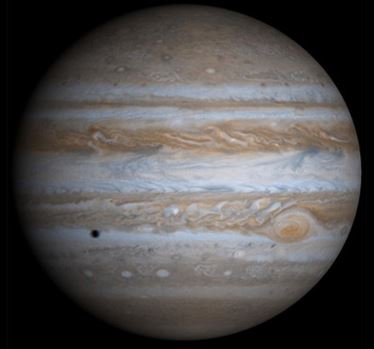

| Visitors Now: | |
| Total Visits: | |
| Total Stories: |

| Story Views | |
| Now: | |
| Last Hour: | |
| Last 24 Hours: | |
| Total: | |
Jupiter And Saturn’s Possible Origins
New stars are surrounded by rotating gas disks during the early stages of their lives. Gas giant planets are thought to form in the presence of these disks.
Observations of young stars that still have these gas disks demonstrate that sun-like stars undergo periodic outbursts, lasting about 100 years, which transfer mass from the disk onto the young star, increasing its luminosity. It is thought that these short bursts of mass accretion are driven by marginal gravitational instability in the gas disk.
While cruising around Saturn in early October 2004, Cassini captured a series of images that have been composed into this large global natural color view of Saturn and its rings.

There are competing theories for how gas giant planets form around proto-suns. One proposes that the planets formed from slowly growing ice and rock cores, followed by rapid accretion of gas from the surrounding disk. The other theory proposes that clumps of dense gas form in spiral arms, increasing in mass and density, forming a gas giant planet in a single step.
Boss developed highly detailed, three dimensional models demonstrating that regardless of how gas giant planets form, they should have been able to survive periodic outbursts of mass transfer from the gas disk onto the young star. One model similar to our own Solar System was stable for more than 1,000 years, while another model containing planets similar to our Jupiter and Saturn was stable for more than 3,800 years. The models showed that these planets were able to avoid being forced to migrate inward to be swallowed by the growing proto-sun, or being tossed completely out of the planetary system by close encounters with each other.
“Gas giant planets, once formed, can be hard to destroy,” said Boss, “even during the energetic outbursts that young stars experience.”
Given that searches for extrasolar gas giant planets have found them to be present around about 20% of sun-like stars, this is a reassuring outcome. It suggests that our improved theoretical understanding of the formation and orbital evolution of gas giants is on the right track.
This research was supported in part by the NASA Origins of Solar Systems Program and contributed to in part to the NASA Astrobiology Institute. The calculations were performed on the Carnegie Alpha Cluster, the purchase of which was partially supported by a NSF Major Research Instrumentation grant.
The Carnegie Institution for Science is a private, nonprofit organization headquartered in Washington, D.C., with six research departments throughout the U.S. Since its founding in 1902, the Carnegie Institution has been a pioneering force in basic scientific research. Carnegie scientists are leaders in plant biology, developmental biology, astronomy, materials science, global ecology, and Earth and planetary science.
2013-03-06 09:16:13
Source: http://nanopatentsandinnovations.blogspot.com/2013/03/jupiter-and-saturns-possible-origins.html
Source:



